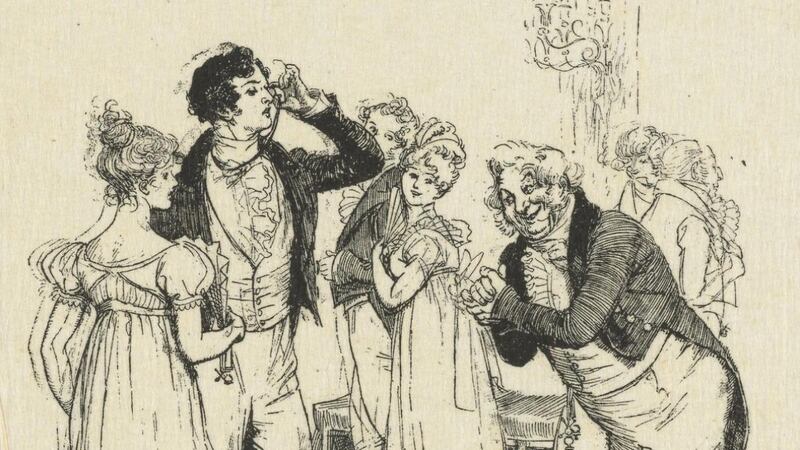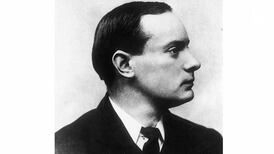He was “the Colin Firth of Jane Austen illustrators”, according to Devoney Looser, author of The Making of Jane Austen (2017), because “it’s difficult to conceive a future artist having a longer-lasting influence on how generations of readers imagined Austen’s characters and scenes”. Looser was referring to Co Derry-born Hugh Thomson, the centenary of whose death is on May 7th.
“Hugh Thomson is regarded as one of the Victorian era’s most talented book illustrators. He was incredibly prolific and the quality of his drawings was amazing,” said Helen Perry, Coleraine Museum Services Officer, when the museum purchased a collection of his work in 2007.
He was born on Church Street, now Kingsgate Street, Coleraine on June 1st, 1860, and attended the model school in the town. After leaving school at 14, he became apprenticed to a linen manufacturer.

He had been fond of drawing at school, filling his copybooks with drawings of horses, dogs and ships.
It has been suggested that his artistic talent was recognised by John Campbell, who worked in the linen trade and who recommended him to his friend John Vinycomb, head of the art department of Marcus Ward and Co, a leading Belfast printer and publisher.
Now aged 16, Thomson moved to Belfast to work at Ward and Co.
Although he attended some classes at Belfast School of Art, he was mostly self-taught, but with Vinycomb’s help and encouragement, he made significant progress.
In 1883, he moved to London to further realise his artistic ambitions.
Of the portfolio he took with him, Helen Perry said: “The work is quite amazing for a young designer and is very accomplished. He could turn his hand to anything and he could illustrate in a number of mediums, including ink and wash, which was a testament to his training at Ward and Co.”
He displayed remarkable attention to detail, was particularly good at capturing light and shade and was gifted at portraying the stances and expressions of animals.
He returned to Belfast in 1884 to marry Jessie Naismith Miller; the couple had one child, John, born in 1886.
In London, he worked for Macmillan and Co’s recently established periodical the English Illustrated Magazine.
He became well known for his illustrations of 18th-century ballads and stories, which led to Coaching Days and Coaching Ways (1888), a collaboration with fellow illustrator Herbert Railton and writer W Outram Tristram.
Thomson’s drawings were based on careful and thorough research carried out in the British Museum and the Victoria and Albert Museum.
Macmillan commissioned him to illustrate a series of English classics, including works by Thackeray, George Eliot, Dickens and JM Barrie and especially six of the novels of Jane Austen.
He was praised for being able to “project himself into a story” (no doubt based on the thoroughness of his research and preparation), so that his work became inseparable from the story editions themselves, as noted in the case of the Austen novels by Devoney Looser above.
He also illustrated 12 of the volumes in the Macmillan topographical series known as Highways and Byways. What gave him particular pleasure was the one set in Ireland, Highways and Byways in Donegal and Antrim (1899), with text by Stephen Gwynn, for which he produced some notable pen-and-ink character sketches.
While he is best known for his pen-and-ink drawings and they were mainly in black and white, he occasionally produced watercolours.
In response to a growing demand at the beginning of the 20th century, he began to add colour to his illustrations and the last two books in the Macmillan Cranford series, to which he contributed from its beginning in 1891, Scenes from a Clerical Life (1906) and Silas Marner (1907), included colour.
The illustrations that he provided for a 1913 edition of JM Barrie’s play Quality Street caused the art critic of the Daily News to comment: “The Barrie-Thomson combination is as perfect in its way as that of Gilbert and Sullivan.” Until recently, the illustrations were used widely on the boxes of Quality Street chocolates.
Having lived in West Kensington and then in Sidcup, Kent, he and his wife lived on Patten Road, Wandsworth Common, London, during the war. Demand for his work dried up during the war years and he faced financial hardship and deteriorating health, eventually dying from heart disease.
In a prolific career, he illustrated some 65 books as well as contributing to magazines and other periodicals in work that was marked by “imagination, charm and humour”, according to Henry Boylan’s Dictionary of Irish Biography.










